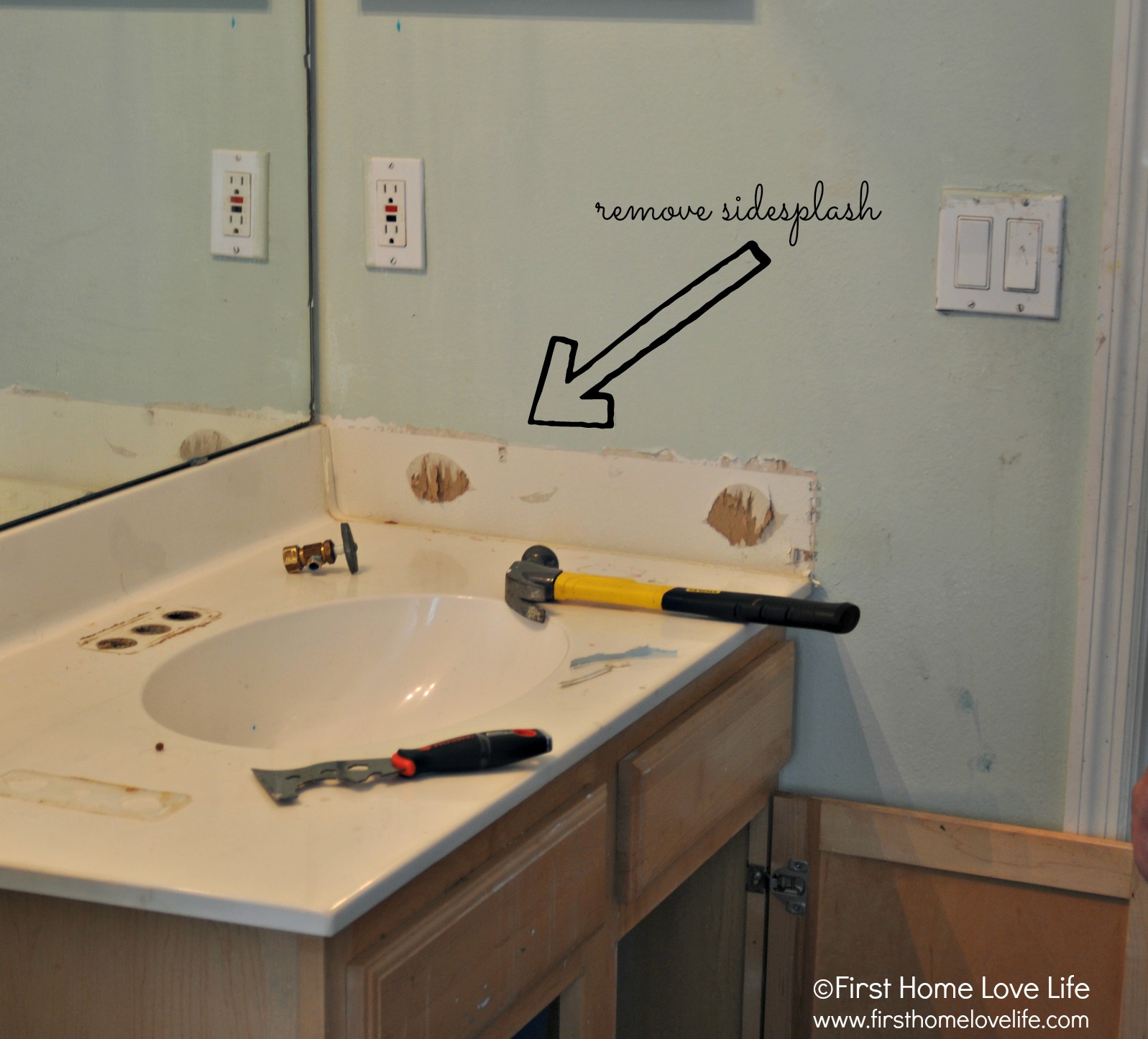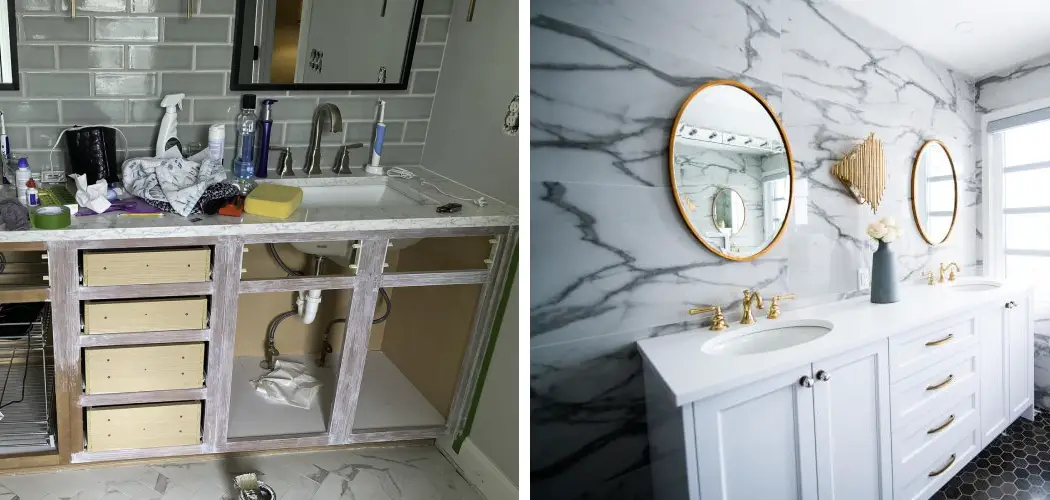Preparing for Removal

Before embarking on the removal process, it is essential to prepare adequately. This involves gathering the necessary tools, taking safety precautions, and disconnecting the cabinet from its utilities.
Tools for Removal
A collection of tools is essential for removing a bathroom cabinet safely and efficiently. These tools include:
- Screwdriver set: A variety of screwdriver heads will be needed to remove screws of different sizes and types.
- Wrench set: Wrenches are used to loosen and tighten nuts and bolts, particularly those securing the cabinet to the wall.
- Pliers: Pliers are helpful for gripping and pulling out stubborn screws or other fasteners.
- Level: A level ensures the cabinet is removed without damaging the surrounding walls.
- Utility knife: A utility knife can be used to cut through any adhesive or caulk that may be holding the cabinet in place.
- Safety glasses: These protect your eyes from debris and falling objects.
- Work gloves: Gloves provide protection for your hands and enhance grip during the removal process.
Safety Precautions
Safety should always be prioritized when removing a bathroom cabinet. Consider the following precautions:
- Turn off the water supply: Before removing the cabinet, turn off the water supply to the bathroom to prevent leaks or flooding.
- Disconnect the electrical supply: If the cabinet has any electrical outlets or fixtures, ensure you disconnect the power supply to avoid electric shock.
- Wear appropriate safety gear: Safety glasses and work gloves should be worn throughout the removal process.
- Clear the surrounding area: Remove any items that could obstruct the removal process or become damaged during the removal.
- Be aware of potential hazards: Be mindful of sharp edges, heavy objects, and potential for falling debris.
Disconnecting from Utilities
Before removing the cabinet, it is crucial to disconnect it from any water and electrical sources.
- Water supply: Locate the shut-off valve for the bathroom water supply. Turn the valve clockwise to shut off the water flow. Once the water is off, open a faucet to drain any remaining water in the pipes.
- Electrical supply: Locate the circuit breaker or fuse box that controls the power to the bathroom. Turn off the appropriate breaker or fuse to disconnect the power supply.
Emptying the Cabinet
Before removing the cabinet, empty its contents. This includes:
- Remove all items from the shelves and drawers.
- Carefully take out any fixtures or accessories, such as towel bars, soap dishes, or mirrors.
- Remove any decorative items or personal belongings.
Disassembling the Cabinet: How To Remove A Bathroom Cabinet

Once you have prepared the area and gathered the necessary tools, you can begin disassembling the bathroom cabinet. This process involves removing the doors and hinges, detaching the cabinet from the wall, and carefully supporting the cabinet during removal to prevent damage.
Removing Doors and Hinges
Before attempting to remove the cabinet from the wall, it is essential to first remove the doors. This is a straightforward process that involves unscrewing the hinges that connect the doors to the cabinet frame. Most bathroom cabinets have either surface-mounted or concealed hinges.
- Surface-mounted hinges are visible on the outside of the cabinet door and are typically attached to the cabinet frame with screws. To remove the door, simply unscrew the hinges from the frame, and carefully lift the door off the hinges.
- Concealed hinges are hidden within the cabinet frame and are often secured with a small clip or lever. To remove the door, locate the clip or lever, and gently release it to detach the door from the hinges.
Detaching the Cabinet from the Wall
After removing the doors, you can begin detaching the cabinet from the wall. This process involves removing the screws and brackets that secure the cabinet to the wall studs.
- Locate the screws and brackets that are holding the cabinet to the wall. These are typically located on the back of the cabinet, near the top and bottom.
- Use a screwdriver to remove the screws, carefully supporting the cabinet as you do so.
- Once the screws are removed, gently pull the cabinet away from the wall, making sure to avoid any sharp edges.
Supporting the Cabinet During Removal
It is crucial to support the cabinet during removal to prevent it from falling and causing damage. This can be achieved by using a helper or by placing sturdy supports underneath the cabinet.
- If you are working alone, you can use a sturdy ladder or a set of sawhorses to support the cabinet as you remove it from the wall.
- If you have a helper, they can help you hold the cabinet while you remove the screws and brackets.
Cabinet Design Variations, How to remove a bathroom cabinet
The specific removal techniques may vary depending on the design of the bathroom cabinet. Here is a table comparing different cabinet designs and their corresponding removal methods:
| Cabinet Design | Removal Technique |
|---|---|
| Standard Cabinet with Surface-Mounted Hinges | Unscrew hinges, remove doors, detach cabinet from wall using screws and brackets. |
| Cabinet with Concealed Hinges | Release hinges, remove doors, detach cabinet from wall using screws and brackets. |
| Floating Cabinet | Remove screws and brackets that secure the cabinet to the wall, carefully support the cabinet during removal. |
Disposal and Cleanup

Once you have successfully removed the bathroom cabinet, the next step is to dispose of it properly and clean up the area. This section provides a detailed guide on how to recycle the cabinet components, clean the area, and repair any wall damage.
Disposal Methods and Recycling Options
Proper disposal of the cabinet and its components is crucial for environmental sustainability. The following flowchart illustrates the common disposal methods and recycling options:
Caption: This flowchart illustrates the disposal methods for bathroom cabinet components. It starts with the question: “Is the component recyclable?” If yes, it directs to the “Recycling” box, which then asks: “Is the component made of wood?” If yes, it directs to “Wood Recycling,” otherwise, it directs to “Other Recycling.” If the component is not recyclable, it directs to the “Landfill” box.
The following table provides a comprehensive overview of common materials found in bathroom cabinets and their recycling options:
| Material | Recycling Options |
|---|---|
| Wood |
|
| Metal |
|
| Glass |
|
| Plastic |
|
Cleaning the Area
After removing the cabinet, it is essential to thoroughly clean the area to remove any debris, dust, or residue. Here are some tips:
- Use a vacuum cleaner with a brush attachment to remove dust and debris from the wall and floor.
- Wipe down the wall and floor with a damp cloth to remove any remaining residue.
- If there are any stubborn stains, use a mild cleaning solution and a scrub brush to remove them.
- Ensure the area is completely dry before proceeding to the next step.
Repairing Wall Damage
During the cabinet removal process, there is a chance of causing damage to the wall. Here’s how to repair any damage:
- Small holes and cracks: Use spackle or patching compound to fill in the holes and cracks. Apply a thin layer and smooth it out with a putty knife. Allow the spackle to dry completely before sanding it down with fine-grit sandpaper.
- Larger holes: Use a drywall patch or mesh patch to repair larger holes. Secure the patch with drywall screws and apply spackle around the edges. Allow the spackle to dry completely before sanding it down with fine-grit sandpaper.
- Paint: Once the repairs are complete, prime the area with a primer and then paint it with the same color as the rest of the wall. This will ensure a seamless finish.
How to remove a bathroom cabinet – Taking down a bathroom cabinet might seem like a daunting task, but it’s actually quite simple. Just remember to disconnect any plumbing or electrical connections first. Once you’ve removed the cabinet, you can start planning your dream bathroom decor. Maybe you’ll go for a calming, serene vibe like a green and white bedroom would inspire.
After all, your bathroom should be your personal oasis. Once you’ve got your vision, you can start putting your bathroom back together, one step at a time.
Taking down a bathroom cabinet can be a bit of a chore, but it’s definitely doable. First, you’ll want to empty it out, of course, and then you’ll need to figure out how it’s attached to the wall. If you’re lucky, it’s just a few screws, but you might have to deal with some more complex mounting systems.
Once you’ve got the cabinet off the wall, you can start thinking about replacing it. Maybe a sleek 24 wide bathroom cabinet would be a good fit? Whatever you decide, remember to properly dispose of the old cabinet and get ready for your bathroom’s fresh new look!
